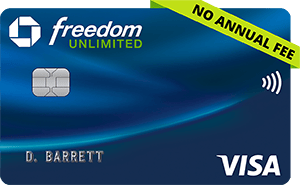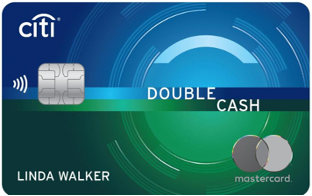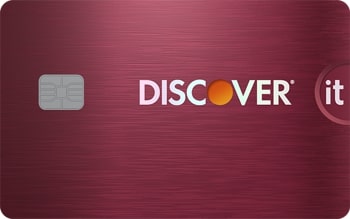Chase Freedom Unlimited Review: A Potential One-Card Solution
The Bottom Line
5.0
The card's rewards structure isn't the easiest to remember. But its useful bonus categories, flexible rewards and outstanding welcome offer make it a top contender among cash-back cards.

Rates, fees and offers
Rates, fees and offers
Annual fee
$0
Rewards rate
1.5%-5%
Bonus offer
Intro Offer: Earn a $200 Bonus after you spend $500 on purchases in your first 3 months from account opening.
Intro APR
0% intro APR on purchases and Balance Transfers for 15 months
Ongoing APR
APR: 18.99%-28.49% Variable APR
Cash Advance APR: 29.24%, Variable
Penalty APR: Up to 29.99%
Balance transfer fee
Either $5 or 5% of the amount of each transfer, whichever is greater.
Foreign transaction fee
3% of each transaction in U.S. dollars
More details from Chase
More details from Chase
- Intro Offer: Earn a $200 Bonus after you spend $500 on purchases in your first 3 months from account opening
- Enjoy 5% cash back on travel purchased through Chase Travel℠, our premier rewards program that lets you redeem rewards for cash back, travel, gift cards and more; 3% cash back on drugstore purchases and dining at restaurants, including takeout and eligible delivery service, and 1.5% on all other purchases.
- No minimum to redeem for cash back. You can choose to receive a statement credit or direct deposit into most U.S. checking and savings accounts. Cash Back rewards do not expire as long as your account is open!
- Enjoy 0% Intro APR for 15 months from account opening on purchases and balance transfers, then a variable APR of 18.99% - 28.49%.
- No annual fee – You won't have to pay an annual fee for all the great features that come with your Freedom Unlimited® card
- Keep tabs on your credit health, Chase Credit Journey helps you monitor your credit with free access to your latest score, alerts, and more.
- Member FDIC

Pros and Cons
Pros
No annual fee
Intro APR period
High rewards rate
No minimum redemption amount
Cons
Requires good/excellent credit
Detailed Review
The Chase Freedom Unlimited® offers a compelling combination of valuable rewards, flexible redemption options, a lengthy 0% introductory APR period and a great sign-up bonus — all for an annual fee of $0.
The Chase Freedom Unlimited® earns 3% cash back on restaurants and drugstore purchases, 5% back on travel booked through Chase and 1.5% back on other purchases. Put that together and you have a card that can really pile up the cash back. And if you carry other credit cards that also earn Chase Ultimate Rewards® points, it packs even more value.
But all those different rewards rates make the card more complicated than competitors that offer a simpler 1.5% back on everything. One remedy: Make the Chase Freedom Unlimited® a top-of-wallet card for every purchase, and you’ll be sure to score those bonus rewards without having to think much about it.
It’s why this card makes a compelling case to be a one-card solution among cash-back credit cards.
Chase Freedom Unlimited®: Basics
Card type: Cash back.
Annual fee: $0.
Sign-up bonus: Intro Offer: Earn a $200 Bonus after you spend $500 on purchases in your first 3 months from account opening.
Rewards:
5% back on travel booked through Chase.
3% back at restaurants, including takeout and eligible delivery services.
3% back on drugstore purchases.
Through September 2027, 2% back on qualifying Lyft services purchased through the Lyft app.
1.5% cash back on everything else.
Interest rate: 0% intro APR on purchases and Balance Transfers for 15 months, and then the ongoing APR of 18.99%-28.49% Variable APR.
Foreign transaction fee: 3%.
Chase Ultimate Rewards® points
Although the Chase Freedom Unlimited® is marketed as a cash-back card, your spending actually earns Chase Ultimate Rewards® points. Points are worth a penny apiece when redeemed for cash back, thus you get 1.5% cash back or more depending on the category of your purchase. Points may also be redeemed for:
Gift cards at 1 cent per point.
Travel booked through Chase at 1 cent per point.
Amazon purchases at 0.8 cent per point.
The Chase Freedom Unlimited® is an excellent card on its own, but it's even better as a companion to other cards that earn Chase Ultimate Rewards® points. More on that below.
Chase Freedom Unlimited® vs. Chase Freedom Flex®
If you're looking at the Chase Freedom Unlimited®, it's logical to wonder how it compares with the similarly named Chase Freedom Flex®.
Both Freedom-branded cards have an annual fee of $0, and both offer lucrative ways to earn cash back.
The choice mostly comes down to rewards: 5% quarterly rotating categories on the Chase Freedom Flex® or the 1.5% “everything else” (instead of 1% everything else) of the Chase Freedom Unlimited®.
A quick evaluation:
Chase Freedom Flex®: The 5% cash back is enticing but complicated. Bonus cash back is also capped at $1,500 per quarter in spending before reverting to 1% back. Category activation is required; all other purchases earn 1% cash back.
Chase Freedom Unlimited®: The 1.5% back on everything else is less exciting but simpler and way more flexible.
Which is more valuable will depend on how well the rotating bonus categories of the Chase Freedom Flex® match your spending. It also depends on how much you spend overall. Big spenders might get more value from 1.5% on everything else because it’s unlimited.
The Chase Freedom Unlimited® runs on the Visa payment network, while the Chase Freedom Flex® is a Mastercard. In terms of acceptance, it doesn't matter much if you carry a Visa or a Mastercard. But Visa and Mastercard do offer some differing side perks.
The table in the dropdown menu below highlights the differences in rewards between the two cards and the older Chase Freedom®, which is no longer accepting applications and has been effectively replaced by the Chase Freedom Flex®.
Click to see the Freedom cards compared side by side
| Empty Table Header | Chase Freedom Unlimited® | Chase Freedom Flex® | Chase Freedom® |
|---|---|---|---|
Offer for new cardholders: | Intro Offer: Earn a $200 Bonus after you spend $500 on purchases in your first 3 months from account opening. | Earn a $200 Bonus after you spend $500 on purchases in your first 3 months from account opening. | None — card is no longer accepting applications |
Rotating bonus categories: | None. | • 5% back on quarterly bonus categories that you activate, on up to $1,500 per quarter in spending. | |
Ongoing bonus categories: | • 5% cash back on travel booked through Chase. • 3% cash back at restaurants, including takeout and eligible delivery services. • 3% cash back on drugstore purchases. | None. | |
Rewards on other purchases: | 1.5% cash back | 1% cash back | 1% cash back |
For more information on which of these Freedom credit cards is right for you, see our full comparison story.
(There is yet another rewards-earning Freedom product — the Chase Freedom Rise® — but unlike the cards above, it is meant for beginners to credit.)
Compare to Other Cards

Benefits and Perks
As a cash-back card, the Chase Freedom Unlimited® delivers a great treat for new cardholders followed by high ongoing value at a low cost. Its best features include:
Rich sign-up bonus
The bonus on the Chase Freedom Unlimited® is relatively rich and relatively easy to earn: Intro Offer: Earn a $200 Bonus after you spend $500 on purchases in your first 3 months from account opening.
Comparable no-fee cash-back cards nowadays offer bonuses of around $200.
Useful bonus categories
The bonus rewards categories are useful and lucrative:
3% back at restaurants, including takeout and eligible delivery services.
3% back on drugstore purchases.
5% back on travel purchased through Chase.
Through March 31, 2025, 5% back on qualifying Lyft services purchased through the Lyft app.
Restaurants and drugstores are especially useful rewards categories for many households. Spend $3,000 a year combined in those categories, and you’ll earn $90 annually.
And if you book travel through Chase, 5% can add up quickly on pricey travel itineraries. Vacation travel costing $6,000 gets you back $300, for example.
1.5% on 'everything else'
Cash-back credit cards with bonus categories, like 3% back on restaurants, typically offer 1% cash back on “everything else.” The Chase Freedom Unlimited® offers 1.5% back on everything else.
While 0.5% more doesn’t seem like much, it adds up for big spenders because it has no limit. And many big-ticket expenses seldom fall neatly into typical bonus categories — think medical bills, car tires and furnace repair.
For those who spend a lot, say $5,000 per month on “everything else,” the extra 0.5% rate on the Chase Freedom Unlimited® means an extra $300 a year in cash back, compared with its typical competitors.
Point transfers to maximize value
Because Chase allows you to transfer its points among cards that earn them, the Chase Freedom Unlimited® can be a cornerstone of a strategy to get maximum value out of every dollar you spend. If you have multiple Chase cards, you can:
Earn more points by splitting your spending between this card and the Chase Freedom Flex. By using the Chase Freedom Flex for purchases in the 5% bonus categories and the Chase Freedom Unlimited® on all other spending, you'd boost your overall rewards earnings significantly.
Get more value per point by transferring rewards to a card with elevated redemption values. Points earned with this card are usually worth a penny apiece. But with several Chase cards — the Chase Sapphire Preferred® Card, Chase Sapphire Reserve® and Ink Business Preferred® Credit Card — points are worth more when you use them to book travel through Chase's online portal.
These three cards also allow you to transfer points at a 1:1 ratio to about a dozen airline and hotel loyalty programs, including United Airlines, Southwest Airlines, JetBlue, Marriott and Hyatt. Depending on how you use transferred points, you could reap even more value.
» MORE: What is the 'Chase trifecta'?
MORE NERDY PERSPECTIVES
 | The Chase Freedom Unlimited is my everyday card. I love that it earns 3% on dining and at drugstores and 1.5% on anything outside of the bonus categories. Plus, any rewards I accrue with the card can be transfered to my Chase Sapphire Preferred for added value when I want to book travel. Jae Bratton, writer, credit cards |
 | I recommend this card to many young people in my life who maybe have only had one card and are ready to elevate their credit cards game a bit. The card is a good choice for beginners with a good credit score because it offers a solid 1.5% back outside of bonus categories, doesn’t charge an annual fee and offers uncomplicated and flexible redemptions options. Funto Omojola, writer, credit cards |
I am pleasantly surprised with how much the Freedom Unlimited can add to your Chase points balance. I rack up so many rewards with the 1.5% back on everything and 3% back on dining and drugstores, and then transfer those points to my Sapphire Preferred when I want to redeem them for travel at a higher redemption rate than I could get with cash back. Meghan Coyle, editor, travel rewards |
Drawbacks and Considerations
It’s complicated
The 1.5% flat rate is easy enough to understand, but the mix of reward rates in other spending categories is head-spinning — especially for cash-back lovers, who tend to value simplicity.
If you don’t want to carry around a rewards cheat sheet to optimally use a credit card and you’re just interested in cash-back rewards — not necessarily Chase Ultimate Rewards® — the Wells Fargo Active Cash® Card is one of the best flat-rate cards on the market. It offers 2% cash back on everything — and not just for a limited time.
Better rates available in specific categories
Cards with rewards bonus categories are most valuable when you spend a significant amount in those categories.
Alternative options include:
The Blue Cash Preferred® Card from American Express pays an industry-leading 6% cash back* at U.S. supermarkets on up to $6,000 a year in spending (then 1%), plus 6% on select U.S. streaming subscriptions, 3% at U.S. gas stations, 3% on transit and 1% on all other spending. Terms apply (see rates and fees). It comes at a cost, though: A $0 intro annual fee for the first year, then $95. Terms apply. This is an ideal card for high grocery spenders.
The Bank of America® Customized Cash Rewards credit card pays 3% in a category of your choice (gas/EV charging, online shopping (including cable, phone, internet and streaming services), dining, travel, drugstores or home improvement/furnishings) and 2% at grocery stores and wholesale clubs, on up to $2,500 in combined choice-category/grocery-store/wholesale-club spending per quarter. All other spending earns 1% cash back.
You can find out more about how this cash-back credit card compares versus the competition by visiting our list of best credit cards to get.
How To Decide If It's Right For You
The Chase Freedom Unlimited® is a great deal for consumers — especially for those who already have the Chase Sapphire Preferred® Card or Chase Sapphire Reserve®.
It comes with a rich sign-up offer, useful bonus rewards categories and plenty of options for cashing in rewards. It’s not as simple as a flat-rate cash-back card, but its versatility and value make it a strong choice.
• • •
To view rates and fees of the Blue Cash Preferred® Card from American Express, see this page.
*Cash Back is received in the form of Reward Dollars that can be redeemed as a statement credit or at Amazon.com checkout.
Looking For Something Else?
Methodology
NerdWallet reviews credit cards with an eye toward both the quantitative and qualitative features of a card. Quantitative features are those that boil down to dollars and cents, such as fees, interest rates, rewards (including earning rates and redemption values) and the cash value of benefits and perks. Qualitative factors are those that affect how easy or difficult it is for a typical cardholder to get good value from the card. They include such things as the ease of application, simplicity of the rewards structure, the likelihood of using certain features, and whether a card is well-suited to everyday use or is best reserved for specific purchases. Our star ratings serve as a general gauge of how each card compares with others in its class, but star ratings are intended to be just one consideration when a consumer is choosing a credit card. Learn how NerdWallet rates credit cards.
Frequently asked questions
What are the rewards on the Chase Freedom Unlimited?
What are the rewards on the Chase Freedom Unlimited?
Cardholders earn 5% back on travel booked through Chase and 3% back at restaurants and drugstore purchases. All other purchases earn 1.5% back. Plus, through March 31, 2025, cardholders earn 5% back on qualifying Lyft services purchased through the Lyft app.
Is Chase Freedom Unlimited hard to get?
Is Chase Freedom Unlimited hard to get?
You’ll need good to excellent credit to qualify for the Chase Freedom Unlimited®. Generally speaking, this is defined as a credit score of 690 or better. But a credit score alone isn’t enough to qualify for any credit card. Issuers take into account your income, existing debts and other information.
Which is better: Chase Freedom Unlimited or Chase Freedom Flex?
Which is better: Chase Freedom Unlimited or Chase Freedom Flex?
It depends on your spending habits. The cards have identical sign-up bonuses, 0% APR periods and $0 annual fees. The main difference is in the rewards. The travel, restaurant and drugstore rewards are the same on both cards. But the Chase Freedom Unlimited® offers a solid 1.5% back on "everything else," while the Chase Freedom Flex® offers 5% cash back in rotating quarterly categories and 1% on other spending.
Does Chase Freedom Unlimited have an annual fee?
Does Chase Freedom Unlimited have an annual fee?
The annual fee on the Chase Freedom Unlimited® is $0.
Is Chase Freedom Unlimited a Visa or Mastercard?
Is Chase Freedom Unlimited a Visa or Mastercard?
The Chase Freedom Unlimited® is a Visa.
Does Chase Freedom Unlimited have a sign-up bonus?
Does Chase Freedom Unlimited have a sign-up bonus?
Yes. The bonus is: Intro Offer: Earn a $200 Bonus after you spend $500 on purchases in your first 3 months from account opening.
Can I have both Chase Freedom Unlimited and Chase Freedom Flex?
Can I have both Chase Freedom Unlimited and Chase Freedom Flex?
Yes. The cards have some identical rewards, but you can use them together to maximize your cash back.
About the authors

Claire Tsosie
Managing Editor
Gregory Karp
Senior Writer



